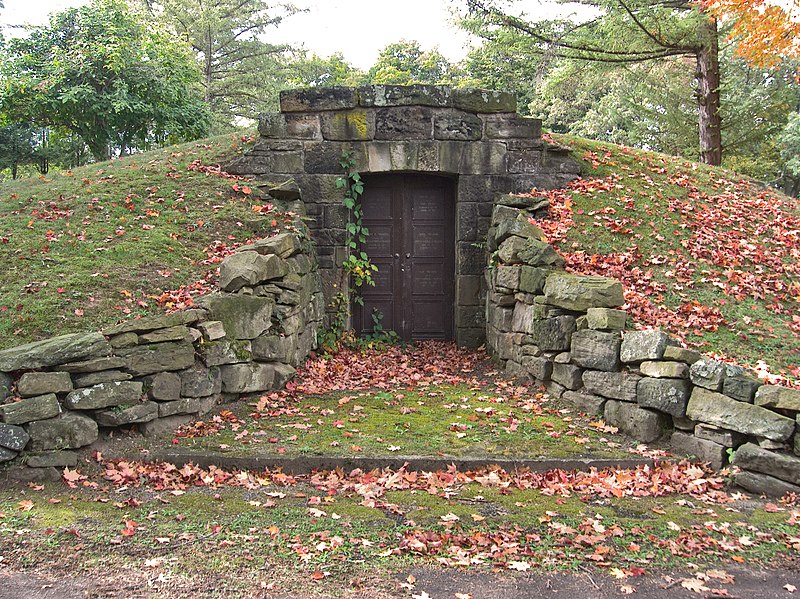Here is the very last gasp of the Egyptian style. The mausoleum is thoroughly modern and simple, but still has the shape and winged sun disk to show that it is meant to be Egyptian.
-
-
Robb Monument, Allegheny Cemetery
With bonus deer. This exceptionally grand monument is in the most romantic interpretation of the Gothic style. Although C. W. Robb lived until 1892, from the style Father Pitt is almost certain that this was put up when his wife Caroline Amelia died in 1869. C. W. married again; his second wife was nearly thirty years younger than he was, and lived until 1936. She shares a small headstone nearby with their daughter, who also died in 1936.
For some reason, Father Pitt suspects that C. W. Robb may have been an organist.
-
Walker Mausoleum, Highwood Cemetery
In-ground burial vaults like this had gone out of fashion in most of our cemeteries by the late nineteenth century, but there are two later ones in the Highwood Cemetery. This one, with its rustic stone, is indescribably picturesque and looks like a relic of some vanished ancient culture, but it probably dates from about 1880.
-
Mary and Samuel Stewart Monuments, Bethany Cemetery
These matching monuments have been a little damaged by time, but still make an impressive pair. Mary’s has a profile vignette that looks as though it is meant for a portrait of the deceased. Small as it is, it is a fine piece of work.
In Memory of
SAMUEL STEWART
who departed this life
March 25, 1855,
Aged 74 years
6 mos & 3 days.MARY STEWART
Consort of
SAMUEL STEWART
who — — —death
— — from — —
Sept. the 2, 1842,
In the 61st year
of her ageFather Pitt was not able to read the entire inscription. In fact Mary’s monument is covered with inscriptions on all sides, most of which seem from the form of them to be poems or hymns, but which have been made illegible by the gradual erosion of the marble. We can, however, read the signature of the artist: “Ed. WILKINS PITT.”
On the back of the monument is another profile, smaller and much more eroded than the one on the front:
Father Pitt suspects that it may represent a son who died in childhood.
-
Master of the Italic Dates
Father Pitt is being a little facetious in bestowing the title “master” on this particular craftsman. He is not exceptionally good. We name him, as usual, from a readily identified feature of his style: he always carves the date in italic letters. And it is interesting to see his work in two different cemeteries, fairly far apart. Above, John Frew’s tombstone in the St. Clair Cemetery, Mount Lebanon. The unusual inset name is unique in what Father Pitt has seen of this craftsman’s work, and he suspects it represents, not an aesthetic decision, but an embarrassing correction of the deceased’s name. William Frew‘s, below, is more typical.
Now here are several tombstones in Hiland Cemetery, north of West View. Note that the name “Richey” or “Ritchey” is spelled two different ways, suggesting that John Frew’s tombstone is not the only one in his career where our artist misspelled a name.




















